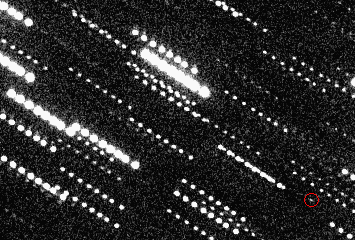
Credit & Copyright: Reiner Stoss, Starkenburg Observatory, Heppenheim, Germany
On the late evening of February 24th 2003 a new Near-Earth Object (NEO) candidate, discovered by astronomer at the Klet Observatory in the Czech Republic, was added on the Minor Planet Center's NEO Confirmation Page. Matthias Busch and Reiner Stoss at the Starkenburg Observatory in Germany confirmed the object only 2.5 hours after the discovery, and they tracked the faint, very fast moving NEO candidate for about three hours. More follow-up observations were collected later, and orbital calculations soon suggested that the object was in orbit around the Earth. Tony Beresford in Australia finally identified it with the old IMP-8 spacecraft, which was launched back in 1973. IMP-8 is the last of ten Interplanetary Monitoring Platforms (IMPs), launched to measure the magnetic fields, plasmas, and energetic charged particles of the Earth's magnetotail and magnetosheath and of the near-Earth solar wind. This satellite was a drum-shaped spacecraft, only about 135.6 cm across and 157.4 cm high.

This short animation, showing the rapid motion of IMPC-8 across the sky, was composed from five images taken by Matthias Busch and Reiner Stoss with a Apogee AP-7 CCD camera at the 0.45m f/4.4 Newtonian reflector of the Starkenburg Observatory. Each of these five frames is composed from seven to eight individual expsures of five seconds each, which were stacked with Astrometrica to compensate for the objects motion of about 1" per time second. The brightness of the spacecraft at that time was about 18.5 magnitudes.
Related Links: